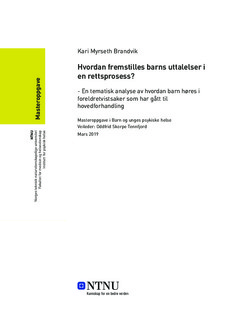| dc.contributor.advisor | Tennfjord, Oddfrid Skorpe | |
| dc.contributor.author | Brandvik, Kari Myrseth | |
| dc.date.accessioned | 2019-09-19T14:01:34Z | |
| dc.date.available | 2019-09-19T14:01:34Z | |
| dc.date.issued | 2019 | |
| dc.identifier.uri | http://hdl.handle.net/11250/2617787 | |
| dc.description.abstract | Denne kvalitative studien undersøker hvordan barn blir hørt i foreldretvistsaker som har gått til hovedforhandling. Målet med studien er å få et innblikk i hvordan barns uttalelser fremstilles i en rettslig høring og hvilke forståelsesrammer eller diskurser som preger denne fremstillingen i referatene fra høringen og i domsavsigelsen.
Datamaterialet består av 6 referater fra barnehøringene og de tilhørende tingrettsdommer. Barna som ble hørt var i alderen 5-10 år. Referatene ble analysert ved hjelp av tematisk analyse, og materialet er sortert i fire kategorier: Rammene for høring av barn og barnets rettigheter, beskrivelser av barnets relasjoner, fremstillingen av barnets troverdighet og forholdet mellom barnets uttalelser og dommers bestemmelse av bo og samvær.
Analysen viste at referatene unnlot å nevne om barnet var blitt informert om sine rettigheter og hvilke konsekvenser uttalelsen deres kan få. Konfliktnivået mellom foreldrene og hvordan dette berører barnet, er ikke tematisert. Videre blir barna framstilt som troverdige under visse forutsetninger. I tillegg er referatenes form og innhold, og relasjonen mellom referat og dom, vurdert opp mot en rettighetsdiskurs. Både tilretteleggingen for barnehøringen og framstilling av barna, bygger opp under denne diskursen, der det forutsettes et syn på barn som kompetent til å uttale seg om viktige spørsmål i dets liv (uttrykt i diskursen «Det kompetente barnet»). Samtidig viser studien også at barns sårbarhet blir tatt hensyn til i en høringskontekst (uttrykt i diskursen «Det sårbare barnet»). Dommene vektlegger barnets uttalelser avhengig av alder og modenhet, men samtidig er disse uttalelsene en av flere faktorer som er avgjørende for beslutningen om bo- og samværsordning. Et særlig funn var at referatene i all hovedsak fremstiller det som uproblematisk for barn å uttale seg om bo- og samværsordning. Funnene drøftes opp mot relevant teori. | |
| dc.description.abstract | The aim of this study is to explore how children are heard in a court process in Norwegian custody cases. This qualitative study uses a thematic analytic approach in order to reveal the prevalent discourses regarding our view on children and see how these discourses influence and shape the settings of the court.
The documents analyzed are the written reports from the interviews from the hearing of the children. The children, 6 in total, were aged between 5 and 10. Thematic analysis identified four different categories or groups in the material; (1) The circumstances for the hearing of the child or how the interviews were performed (2) How the children's familiar relationship or framework were described, (3) How the children's trustworthiness are described, and at last (4) The relationship between how the children have expressed themselves and the final rulings made by the court.
The material used in this qualitative study is limited and the conclusions should be handled with care. However, a main finding from the thematic analysis is that information obtained from a child is generally evaluated as trustworthy, especially when obtained in an interview by a qualified person talking to the child alone. The child is considered as competent, trustworthy and should be heard in the court process. However, the circumstances for the interview, age and maturity and conflict level surrounding the child are also important for how the court evaluate the trustworthiness of the child. The child is identified as the vulnerable part in the conflict. Finally, the findings are discussed with regard to the discourses that the study argues is a part of our society, i.e. “The competent child” and “The vulnerable child” and relevant theory. | |
| dc.language | nob | |
| dc.publisher | NTNU | |
| dc.title | Hvordan fremstilles barns uttalelser i en rettsprosess? En tematisk analyse av hvordan barn høres i foreldretvistsaker som har gått til hovedforhandling | |
| dc.type | Master thesis | |
